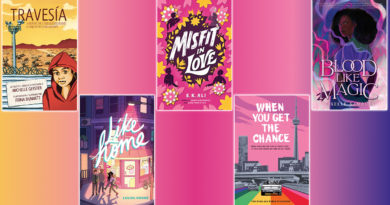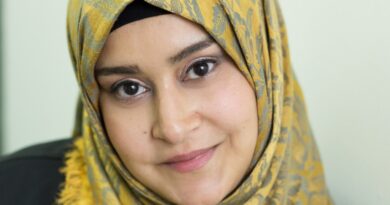Sara Florence Davidson discusses the Sḵ’ad’a Stories Series with SesayArts

The quartet of picturebooks about Haida traditions and ancestral knowledge known collectively as The Sḵ’ad’a Stories is now out in the world. And they are utterly mesmerizing.
Sḵ’ad’a means to learn in the Haida language. The Sḵ’ad’a Stories are co-written by Sara Florence Davidson (Sgaan Jaadgu San Glans) and her father, the renowned Haida artist Robert Davidson. And each story is brought to vibrant life in the sumptuous, meticulously researched illustrations by Janine Gibbons, a multi-disciplinary artist and award-winning illustrator of Haida Raven of the Double-Fin Killer Whale Clan, Brown Bear House.
Based on family stories, the books highlight Indigenous pedagogies and intergenerational learning – particularly the sharing of “land-based, art and cultural knowledge teachings.” Offering a unique blend of traditional Haida principles and contemporary storytelling, the series follows Haida children as they receive valuable lessons from their elders through day-to-day experiences, cultural traditions and time spent in nature.
Sara is a Haida/Settler Assistant Professor in the Faculty of Education at Simon Fraser University with a PhD in literacy education. Inspired by her familial history and cultural heritage, she shares the rich cultural heritage of the Haida community with a wider audience, while instilling in young readers a love for reading, storytelling, and their own cultural heritage. In addition to captivating young readers, the series embodies the Sḵ’ad’a principles of learning that Sara and her father introduced in their educational guidebook, Potlatch as Pedagogy: Learning Through Ceremony, which outlines a holistic, relational, practical, and continuous model for learning.
 The four books in the Sḵ’ad’a Stories Series chronicle different days in the authors’ lives, providing in-depth and immersive insight into Indigenous ways of education and learning. The first two titles, Jigging for Halibut With Tsinii and Learning to Carve Argillite, were published in 2021. They are told from Robert’s perspective before Sara’s birth. The final two picture books in the series, Returning to the Yakoun River and Dancing with My Ancestors, were released last fall. Returning to the Yakoun River is about an experience Sara and her brother Ben shared when their father took them fishing at a river on Haida Gwaii. The final book, Dancing with Our Ancestors, tells the story of Sara and her brother, father and stepmother attending a potlatch in Hydaburg, Alaska.
The four books in the Sḵ’ad’a Stories Series chronicle different days in the authors’ lives, providing in-depth and immersive insight into Indigenous ways of education and learning. The first two titles, Jigging for Halibut With Tsinii and Learning to Carve Argillite, were published in 2021. They are told from Robert’s perspective before Sara’s birth. The final two picture books in the series, Returning to the Yakoun River and Dancing with My Ancestors, were released last fall. Returning to the Yakoun River is about an experience Sara and her brother Ben shared when their father took them fishing at a river on Haida Gwaii. The final book, Dancing with Our Ancestors, tells the story of Sara and her brother, father and stepmother attending a potlatch in Hydaburg, Alaska.
Children will pore over the text and illustrations, and adults will also find the books essential reading that deserves a place on their bookshelves. Following the release of Returning to the Yakoun River and Dancing with My Ancestors, Sara spoke with SesayArts Magazine about the genesis and development of the series, the power of stories to share knowledge, and her hope that the books can inspire readers to share and honour stories from their own families and communities.
SM: This series is absolutely breathtaking – congratulations! Do you want to talk a little bit about when you knew that these stories of family, traditions and ancestral knowledge would make a great picture book series?
SFD: Thank you so much! I have actually been drawn to picture books for a long time. I use them a lot in my classes with all ages (including adults). I thought that the first story, Jigging for Halibut With Tsinii, would make a wonderful picture book, so I approached my publisher. They were very keen and asked for four books. I was stumped for a while because I wasn’t sure which stories I would use, but then I got the idea that the stories could demonstrate a progression of learning and teaching in my father’s life. The stories are related to the stories he told me about his experiences learning, which are described in Potlatch as Pedagogy.
SM: I’m sure that you must have dozens of stories to draw from. Why did you decide on these four stories to form the series (and might there be more books)?

SFD: These are stories that were shared and discussed as we collaborated on Potlatch as Pedagogy. I was also interested in sharing stories that centred the sharing of land-based, art, and cultural knowledge teachings. You will notice that in books 1 and 3, knowledge is being shared about fishing and in books 2 and 4, art and cultural knowledge is being shared. The first two stories are very central in my father’s learning stories and are written from his perspective. The second two are significant experiences in my life and are written from my perspective.
I also wanted to share stories about learning. I believe that storytelling is such a powerful way to share knowledge and we all have experiences learning, so we can relate to these kinds of stories. At this time, there are no plans for more books in this series, but I feel like the door has been left open if it makes sense in the future.
SM: On reading the two most recent titles, it immediately occurred to me that the series could help Indigenous students learn in a more culturally relevant way. How might teachers apply the series to incorporate and affirm Indigenous perspectives in general, as well as Haida community and Sḵ’ad’a principles in particular?
SFD: I hope that sharing the stories will inspire others to share the stories from their families and communities. I believe that this is a way to ensure that the stories we share in our classrooms reflect the students’ voices. I have witnessed how sharing stories with one another helps us to build relationships and that helps us to learn from one another. I also hope that the series will invite educators to engage with Indigenous pedagogies differently – to understand that there is a depth to them. There are so many negative stories about Indigenous peoples in the media, I wanted to be sure that there were other stories about us being shared. The stories inspired the Sḵ’ad’a principles, so I hope they capture the principles in a holistic way. It was never my intention that people would use the principles for teaching away from Haida territory, but I hope they can be used as an example to better understand Indigenous pedagogies. And I hope they inspire educators to learn more about the educational approaches of the local Indigenous communities from the territories they are occupying.
SM: As I read, I thought about how students of diverse racialized and immigrant backgrounds might relate to the theme of intergenerational knowledge-sharing. The books might help them to appreciate and be proud of the learning they receive from their ancestors – a form of education that is often subordinated, undervalued and at risk of being ephemeral. I can see how this series can lead students to affirm their identities, cultures and different ways of learning, and not just in school. What are some ways that teachers can incorporate the series in the classroom and into their literacy programming?

SFD: I collaborated with Katya Adamov Ferguson on an educator guide for the series, which is filled with lots of ideas for bringing these books into the classroom. But when I created the series, I was hopeful that people would see value in their lived experiences and the knowledge shared from their family and community (as opposed to focusing solely on mainstream educational experiences).
When I have spoken about Potlatch as Pedagogy, I have often shared that this was what I learned outside of school after I completed my PhD. I think it is so important for people to remember that we have so many opportunities to learn and they do not take place only in classrooms. I hope that educators use these stories as mentor texts for students of all ages. I have worked with secondary students in the past and now I work with adults and I invite them to share these kinds of stories. I learn so much from reading them.
SM: It goes without saying that Janine Gibbons’ illustrations bring each story to glorious life, and the combination of language and pictures is absolutely stunning! Could you talk a little about the relationship between text and illustration in the series, and what details readers should pay special attention to while reading the books?
SFD: I would encourage readers to look at the images very closely and many times. Janine did a lot of research to illustrate these books, and included many subtle visual details. For example, in Learning to Carve Argillite, she included an image of sharks. It may seem misplaced to the reader, but she learned that in the past, shark skin was used to polish argillite carvings. She wanted to reflect that in the image.
SM: The final word is yours. What question do you wish I had asked you that I didn’t (and what is the answer)?

SFD: What is your hope for these books?
Each book is dedicated to a family member. My father was greatly influenced by Elders in this life. My brother and I grew up hearing stories of the impact those Elders had on the knowledge, work ethic, and values that he has today. Traditionally, the Haida relied on oral tradition to ensure our knowledge was passed from one generation to the next. As a society, we now rely more on written accounts.
I hope that these books will ensure that the contributions of my great-grandfather, my grandfather, my father, and my brother will not be forgotten. I hope that the books will give future generations the opportunity to know them and learn from them.
© Arpita Ghosal, SesayArts Magazine, 2023
About The Author
Arpita Ghosal
Arpita Ghosal is a Toronto-based arts writer. She founded Sesaya in 2004 and SesayArts Magazine in 2012.
Visit About Us > Meet the Team to read Arpita’s full bio …




